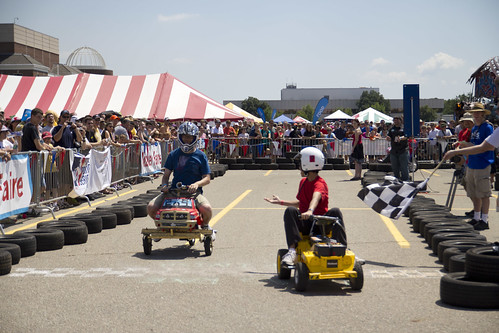I spent this past weekend in Michigan for Maker Faire Detroit at The Henry Ford. There was a lot to see, but I was particularly interested in the hacker/makerspaces. When you hear news about Detroit, it’s usually in reference to the many troubles facing the region, like the city’s recent bankruptcy filing. But hackerspaces in the region aren’t just thriving, they’re growing and evolving. They’re a great example of how people can collaborate to create their own opportunities for education and entrepreneurship, all while having fun.

Geodesic dome and misting umbrella by GR Makers.
There were two new Michigan hackerspaces this year: GR Makers and Lansing Makers Network. Michigan now has hackerspaces in most, if not all, metropolitan areas. GR Makers is worth pointing out, because although they had plenty of projects ranging from whimsical to entrepreneurial, they haven’t even opened their space yet. The question “What tools does a hackerspace need?” is getting a lot of attention right now, but the examples of GR Makers, and several other spaces I’ve followed, suggest that we might be better off asking “What kind of community does a hackerspace need?”

Nate Yost from All Hands Active demonstrates a Kinect-based 3D Scanner.
If new spaces demonstrate the spread of the hackerspace model, the return of older spaces shows that the model can be sustainable. All Hands Active from Ann Arbor, OmniCorpDetroit, and i3 Detroit (of which I’m a founding member) all returned this year. As time goes on, these spaces are looking less like niche clubs, and more like well-established resources for their communities.

Hackerspaces race DIY electric cars in the Power Racing Series.
The Faire drew spaces from outside Michigan as well. Hack Pittsburgh, Hive 13 from Cincinnati, and LVL1 from Louisville all had tents. One of the biggest draws for out-of-towners was the Power Racing Series, in which different hackerspaces compete (and collaborate) to race electric cars built from old Fisher-Price Power Wheels parts. Events like Maker Faire and Power Racing Series have become standard ways for spaces to share both skills and culture.

Silkscreen prints by Oyin Zuri of Mt. Elliott Makerspace.
There were also a few groups better described as makerspaces at the Faire. In addition to the commercially-backed Tech Shop and Maker Works, I was excited to see two educational makerspaces breaking the traditional hacker/makerspace mold. The Mt. Elliott Makerspace, founded by Media Lab Director’s Fellow Jeff Sturges, was holding workshops for kids to build their own speakers from scratch. I also met a local parent named Oyin Zuri. Her daughter learned silkscreen printing at Mt. Elliott, and then taught her how to do it. Now they’re both volunteers at the space. The Detroit Public Library has also opened its own educational youth makerspace, called HYPE. Hackerspaces have been rightly criticized for skewing towards the interests of white, male, young professionals, and these spaces are doing a great job of showing how to include a wider community of makers.
There were of course many spectacular projects to see at Maker Faire (you can read about some of them on the Make blog and mlive). But I find it just as exciting to see the international network of hackerspaces thriving, and to think of the new possibilities that brings to places like Metro Detroit.
